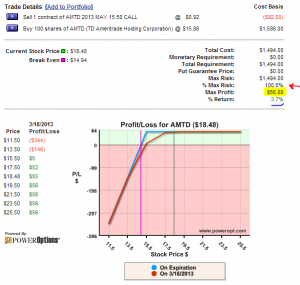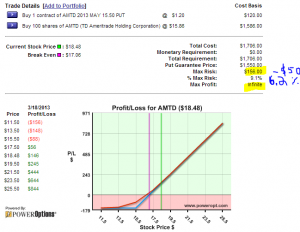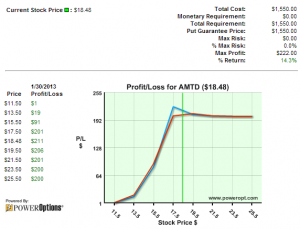In today’s post: yet another example of how Married Puts beat the most popular of options plays, the Covered Call. Plus, what may happen when you combine the two.
Hey Traders! So, I recently completed a coaching session with one of the purchasers or my RadioActive Trading Home Study Kit. He’s pretty excited and so am I.
“Joseph” got the HSK as part of our end-of-year promotion, paying $599 plus shipping for the finest program we have to offer. As we spoke on the phone, I came to find out that Joseph has spent thousands of dollars on options education, only to find out that our twice-weekly free webinars made more sense than any fee-based program he participated in to date.
That’s when I asked him about his current positions.
Joseph has been trading Iron Condors and traditional Covered Calls. One of the positions that he mentioned caught my attention because it was a Covered Call play that he said had been recommended by Motley Fool.
“Ahhh,” I said to Joseph. “Let me show you the error of your ways.” 😉
See, I’m not a “make-you” broker, and I’m not a financial planner. For these reasons I don’t recommend specific stocks. I’m just a regular guy that reverse-hacked and discovered many of the tricks that top-notch hedge fund managers use to make the bacon. So for my trading coaching clients I’m able to give a second set of eyes, and suggest that they use the right tool for the right job, according to their goals. And the VERY FIRST tool in my box is the Married Put play.
Joseph’s Covered Call play looks like this:
If you click to enlarge this pic, you’ll see where I underlined for emphasis the MAXIMUM profit that Joseph can possibly take out of this play. It says $56, or 3.7%… but to be completely fair, this graph is a little bit skewed because of a $0.50 dividend that was paid. It SHOULD read, $106, or 7%. But again, that’s the MAX that Joseph can take out of this trade that he’s in til May. What’s the downside? Says it right there on the summary: 100%. That means that Joseph COULD possibly lose his entire investment. We hope not… but we don’t know now, do we?
All Joseph can count on is that if the advice he got proves to be sound, he can make a maximum of 7%. He may end up losing money on this play, but we won’t know until May.
SOOOoooo… What if instead of selling a covered call back on November 27, Joseph had bought a put option to protect his stock? Let’s look at these historical prices, courtesy of PowerOptions:
You can see there were 707 contracts of the 16 calls traded on November 27. I think a lot of people were following the MF’s advice. Looks like Joseph got filled in the spread when he sold his short call for $0.92. Let’s suppose that Joseph could likewise have gotten filled in the spread buying a May $16 married put for $1.20, right in between the bid of $1.15 and ask of $1.25:
Joseph’s price on the stock was $15.86, offset by the credit of $0.92 he collected for selling a covered call. However, instead of agreeing to sit on this stock for the call holder for six months… if he had BOUGHT a long put to cover himself against sudden downturns in the market, he would be in a better position today.
With the short call, Joseph is looking at a Maximum payout of $1.06 , or 7%, on his shares of AMTD on May expiry. With a long put, though, he is looking at a maximum RISK of $1.06 instead, with the upside left open. It’s the ‘hockey stick’ graph of the Covered Call, only turned right-side up!
They say that hindsight is 20/20. If the Fools over at Motley thought that AMTD was going up… well, they were right. Right good fools. BUT..! The Covered Call play certainly proves Foolish when we look at it. We are bullish, right? Think that the stock will go up? Great. Then WHY would we limit our potential payout if we’re RIGHT down to 7%… while leaving ourselves open to disastrous downturn (see 100% risk in the Covered Call graph above) in case we are wrong?
Here’s where Joseph would be today, had he gotten the RadioActive Trading Home Study Kit back in November. He would have limited his risk down to 6% or so, same as we’ve been teaching for over 10 years now… and would today (1/11/13) be sitting pretty, able to liquidate his AMTD stock for $18.52… his May $15.50 put for .20 cents ( not theoretical pricing… someone got that price today, January 11, 2013! )
That’s $18.72 in after a $17.06 investment, or 9.73%. Not only is that a higher payout for only 6.2% risk… than the Foolish idea only pulls in 7% max while risking everything…
But..! It also happens sooner. Why on earth would we wait til May for a possible maximum payout of 7%, when we could have a certain 9.73% right NOW in January? Hmmm…
Oh, do we still like Covered Calls? Think it’s sexy to get paid for sitting on a stock while other poor shleps are just watching the ups and downs day by day? Heh… then try THIS on for size:
Selling a February $17.50 Covered Call today against this Married Put position would take away all risk. See, of the $1.06 that’s AT RISK in the stock + May put play, .50 cents would already be in pocket for the dividend. A limit order to sell the February $17.50 call at $1.06 would probably get filled right now while the stock’s at $18.52. This $1.56 IN would cancel risk completely in a state that we call, “Bulletproof.” Here’s what the chart looks like:
Notice anything missing? Most folks are looking for the break-even line. It doesn’t exist anymore.
Joseph is happy that he picked up the RadioActive Trading Home Study Kit with support. So am I. Because it matters less WHAT he picks to trade, and matters more HOW he decides to trade it.
7% maximum payout… must hold six months… all the risk of a slide in the stock…
OR..!
Only 6.2% risk to your capital… at first… later 0%… and a max upside of 14.3%.
Which do YOU think is more Foolish?
😉
Welcome aboard, Joseph! I think you’re going to LOVE trading RadioActively. I’m going to enjoy being your coach.
Hey Traders, sound off below. Let me hear what you think of the RadioActive Profit Machine (Long-term in the money Married Put), BULLETPROOFING, keeping risk to single digits but letting winners run… and whether you think I’m crazy or not. Love to hear from you.
Happy Trading,
Kurt
For Free Options Trading Educational Webinars Every Tuesday and Thursday, Register HERE




 I'm Kurt Frankenberg, and I have discovered how to truly put the odds on the side on the individual investor.
I'm Kurt Frankenberg, and I have discovered how to truly put the odds on the side on the individual investor.
Sounds great ! I just subscribed to fusion, I am a little confused, when do I get my first trade.
Hello Dale,
Welcome to Fusion!
Regarding the Fusion trades, most of the listed positions are real trades that Ernie, Kurt or myself are trading. I was looking to open a new RPM last week but I was more focused on the current open positions.
Fusion subscribers can expect to see a new trade this week, between January 28th and Feb. 1st, 2013. You still may be able to evaluate entering one of the open positions where an adjustment or income method has yet to be applied if the at risk amount and underlying security matches your criteria.
Remember, the Fusion positions are not designed as an advisory newsletter service, and are not direct recommendations or suggestions of which stocks to buy and which options to trade. They are designed to be an educational tool so Blueprint and Home Study Kit owners can see how investors would enter and manage a new RPM.
Good article. Examples abound in the Blueprint (BP) of this type. BJ stands for “Bill in Japan”. Therefore, it’s hard to call because of the time zone difference. When I trade I have to stay up late past 1130 or get up early by 5am. Doesn’t leave much time time to talk on the phone and get to work. I got the Blueprint a week ago and half way through it. I have a few “runners” so I’m looking at the insurance tool to apply to STX, HLF, and CIV. CIV is paying special dividend on 5 February.
One question about something in the BP on position sizing: It stated the position size should be 0.5 to 2% of portfolio value? Is that right? Here’s what I do: 4% of portfolio size, use a 25% stop. This means a maximum 1% lost. On a $100k portfolio it is .04x100x.25 = $1,000.
Did I read this right? 2% would only be a $2,000 trade on a $100k portfolio.
Next I’d like to discuss how to get regular income since I’ve been trading covered calls so long. I guess you get hooked on the income. My idea was to start off my “laddering” a few married puts, e.g, setup a few trades in March, then April, then May, etc. Does that make any sense? I know some of these will not be held that long however the aim is a regular monthly income. Or I could just take gains off he table. Any suggestions are welcome. Regards
Hi Bill:
Thanks for picking up the Blueprint! Glad you are already engulfed and applying the knowledge.
Yes, I think you read that right. The idea is to limit the risk of any one trade to 4-8% of the trade itself. And that 4-8% should be no more than 0.5-2% of your whole trading account.
If you have detailed questions about the Blueprint and our method, the best venue for them is direct email. Send your questions and comments to support@radioactivetrading.com
Hi BJ… “Admin” refers to one of the folks in the office that may post a reply when I am unable. But I’d like to weigh in on your question too.
When you mentioned, “2% would only be a $2,000 trade on a $100K portfolio”… yes, that’s almost right. It might actually be a $40K trade, in which you have 5% AT RISK. For example,
400 shares of XYZ at $85 per share
4 $100 put options at $15
Total invested 400 X $100 per share = $40,000
Total Amount AT RISK: $5 per share or $2000
NOW… we have $2,000 AT RISK, though $40K is invested. Later we may Bulletproof this and free up capital by way of margin or substituting an option for stock. But for now, you don’t need to limit yourself to $2,000 trades, just $2,000 losses or less.
Get it?
Write to support@radioactivetrading.com for further Q’s about asset allocation. And check your FORTS (Foundations Of RadioActive Trading) CD for details on diversification.
Happy Trading!
Kurt
Oooh second reply… sorry, forgot to answer your Q about income. Look into Income Method #6, since it can be used for regular income, but solves the two biggest problems with covered calls. You don’t cut off your upside potential for growth when you do IM#6. Also, IM#11 might be a good candidate for you.
Consider getting my cell number from kurt@radioactivetrading.com.
Happy Trading,
Kurt
In the covered call case, considering the call was ITM during ex-div date it would have almost certainly been assigned early and closed out the underlying so no need to wait until May to get full payout.
For the covered call against married put case, if you lock in with a Feb 17.5 for 1.06 premium when the underlying is 18.52, seems you are just capturing .04 of extrinsic. Why not just sell out of the position instead, especially if the long put would actually be decaying over time.